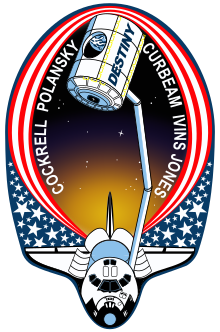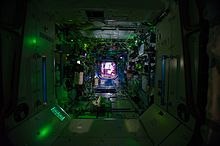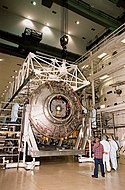Destiny (modul ISS)
| Destiny | |
|---|---|
 Destiny je pomocí robotického ramene vyndávána z raketoplánu | |
| Základní informace | |
| Start | 7. února 2001 |
| Kosmodrom | Mys Canaveral |
| Nosný systém | raketoplán Atlantis (STS-98) |
| Provozovatel | NASA |
| Stav | Aktivní |
| Hmotnost | 14 515 kg |
| Délka | 8,53 m |
| Průměr | 4,27 m |
| Obytný objem | 104,77 m³ |
| Konfigurace | |
 | |
| ISS po připojení modulu Destiny | |
Destiny, známý také jako U.S. Lab, je americký laboratorní modul Mezinárodní vesmírné stanice (ISS).[1][2] Je připojen k modulu Unity.[3] Destiny je prvním orbitálním výzkumným modulem NASA od doby, kdy stanice Skylab v únoru 1974 shořela v atmosféře.
Společnost Boeing zahájila stavbu modulu v roce 1995 v Michoud Assembly Facility a poté v Marshall Space Flight Center v Huntsville v Alabamě.[1] Modul dorazil do Kennedyho vesmírného střediska na Floridě v roce 1998 a v srpnu 2000 byl předán NASA k přípravám před startem. Modul odstartoval 7. února 2001 na palubě raketoplánu Atlantis při misi STS-98.[3]
Astronauti uvnitř modulu provádí výzkum v mnoha vědeckých oborech. Vědci z celého světa výsledky využívají ke zdokonalení svých studií v medicíně, strojírenství, biotechnologii, fyzice, vědě o materiálech a vědě o Zemi.[2]
Start a instalace

Modul odstartoval na palubě raketoplánu Atlantis při misi STS-98.[3] Na oběžnou dráhu Země vstoupil raketoplán s modulem 7. února 2001. 10. února 2001 v 16:50 SEČ začala instalace modulu.[4] Nejprve bylo použito robotické rameno raketoplánu (Canadarm) k odstranění spojovacího adaptéru 2 (PMA 2) z předního portu modulu Unity, aby se vytvořil prostor pro nový modul. Modul byl „zachycen“ robotickým ramenem v 18:23, poté byl vyzvednut z nákladového prostoru raketoplánu a ukotven k přednímu portu modulu Unity. O dva dny později byl PMA-2 přesunut na přední port Destiny.[5] O několik let později, 14. listopadu 2007, byl připojen modul Harmony k přednímu portu Destiny.[6]
Připojení Destiny zvýšilo obyvatelný prostor ISS o téměř 105 m3, což představuje nárůst o 41 procent.[4]
- Raketoplán Atlantis s modulem Destiny míří na startovací rampu
- Posádka mise STS-98 míří na startovací rampu
- Start raketoplánu s modulem Destiny
- Astronaut u modulu Destiny
- ISS po připojení Destiny, únor 2001
Struktura


Americký laboratorní modul je 8,5 m dlouhý a 4,3 m široký.[1][2] Je vyroben z hliníku a nerezové oceli a skládá se ze tří válcových částí a dvou koncových částí, které obsahují poklopy, kterými astronauti vstupují do jiných modulů. Zadní port Destiny je připojen k přednímu portu modulu Unity a přední port Destiny je připojen k zadnímu portu modulu Harmony.[6][7] Na jedné straně modulu je umístěno okno s průměrem 510 mm.
Každý ze dvou kotvících portů na Destiny obsahuje poklop.[2] Oba poklopy jsou otevřené, pokud nenastane situace vyžadující izolaci modulu. Každý poklop má malé okno. Poklopy lze otevírat nebo zavírat z obou stran. Poklopy mají funkci blokování tlaku, která zabraňuje otevření poklopu, pokud je pod poklopem podtlak (vyšší tlak na vnější straně poklopu).
Destiny má opticky čisté skleněné okno s průměrem 510 mm používané primárně pro pozorování Země.[1][2][8] Členové posádky stanice používají statické kamery u okna k záznamu měnící se krajiny. Okenní clona chrání okno před možnými srážkami s mikrometeority a orbitálními úlomky. Posádka ručně otevře závěrku, aby se mohla kouknout z okna.
Snímky zachyceny z okna Destiny daly geologům a meteorologům šanci studovat povodně, laviny, požáry a další.
Specifikace
- Délka: 8,53 m
- Průměr: 4,27 m
- Hmotnost: 14 515 kg
- Tlakový objem: 104,77 m3
Vědecké vybavení

Destiny také obsahuje Minus Eighty Degree Laboratory Freezer pro ISS (MELFI), přivezený na vesmírnou stanici misí STS-121.[9] Je to mrazák, který se používá mimo jiné k ukládání vzorků na stanici.[10]
Aktuálně nainstalovaná je zemědělská kamera (AgCam) v hlavním pozorovacím okně Destiny. Jedná se o multispektrální zobrazovací systém vytvořený a primárně provozovaný studenty a učiteli na University of North Dakota. Jeho účelem je pořizovat časté snímky vegetativních oblastí na Zemi ve viditelném a infračerveném světle a slibuje vyšší účinnost pro sezónní výzkum zemědělských aplikací a podporu provozního rozhodování než současné satelitní systémy, jako je Landsat.[11]
Veggie
V roce 2016 provozovala posádka ISS experiment Veg-03.[12] V listopadu sklidili úrodu jedlého římského salátu, který přispěl k jídlu posádky.[13] V rámci experimentu jsou také na Zemi vzorky zelí k testování.
US Laboratory Science Window
Okno na spodní straně modulu, formálně známé jako US Laboratory Science Window, má „...nejkvalitnější optiku, která kdy letěla na kosmické lodi s člověkem...“, uvádí NASA. Může podporovat pozorování / pořizování snímků Země.[14] V roce 2010 bylo na stanici přivezeno výzkumné zařízení s názvem WORF a první fotografie s ním byla pořízena v lednu 2011.
- Holandský astronaut ESA Andre Kuipers se dívá z US Laboratory Science Window
- Astronautka Susan Helmsová se dívá z US Laboratory Science Window, 2001
- Pohled na okno US Laboratory Science Window s astronauty Susan J. Helms a James S. Voss
Galerie
- Destiny v Kennedyho vesmírném středisku
- Destiny s připojným PMA-2, 2001
- Leroy Chiao v modulu Destiny,
- Alexander Gerst v modulu Destiny
- Victor Glover pracuje v modulu Destiny, březen 2021
- Kjell Lindgren v modulu Destiny, 2015
Reference
V tomto článku byl použit překlad textu z článku Destiny (ISS module) na anglické Wikipedii.
- ↑ a b c d Dostupné online.
- ↑ a b c d e Archivovaná kopie [online]. [cit. 2021-05-13]. Dostupné v archivu pořízeném dne 2007-07-09.
- ↑ a b c Archivovaná kopie [online]. [cit. 2021-05-13]. Dostupné v archivu pořízeném dne 2013-08-30.
- ↑ a b [1]
- ↑ Archivovaná kopie [online]. [cit. 2021-05-13]. Dostupné v archivu pořízeném dne 2012-03-11.
- ↑ a b Archivovaná kopie [online]. [cit. 2021-05-13]. Dostupné v archivu pořízeném dne 2007-10-12.
- ↑ Archivovaná kopie [online]. [cit. 2021-05-13]. Dostupné v archivu pořízeném dne 2008-03-07.
- ↑ Archivovaná kopie [online]. [cit. 2021-05-13]. Dostupné v archivu pořízeném dne 2008-09-06.
- ↑ Archivovaná kopie [online]. [cit. 2021-05-13]. Dostupné v archivu pořízeném dne 2008-10-09.
- ↑ Archivovaná kopie [online]. [cit. 2021-05-13]. Dostupné v archivu pořízeném dne 2008-11-01.
- ↑ Archivovaná kopie [online]. [cit. 2021-05-13]. Dostupné v archivu pořízeném dne 2009-04-04.
- ↑ [2]
- ↑ Archivovaná kopie. www.nasa.gov [online]. [cit. 2021-05-13]. Dostupné v archivu pořízeném z originálu dne 2020-11-08.
- ↑ [3]
Externí odkazy
 Obrázky, zvuky či videa k tématu Destiny na Wikimedia Commons
Obrázky, zvuky či videa k tématu Destiny na Wikimedia Commons
Média použitá na této stránce
An overall shot of the newly attached Destiny laboratory was recorded with a 35mm camera during the early occupancy by astronauts and cosmonauts from the Expedition One and STS-98 crews
A Crawler-Transporter carrying a mobile launch platform (MLP). In turn, the MLP is supporting Space Shuttle Atlantis and Atlantis's solid rocket boosters and external tank. As seen on January 26, 2001, Atlantis is being moved to launch pad 39A in preparation for STS-98. This photograph (facing east from the top of the Vehicle Assembly Building) shows the Crawler near the beginning of its 3.4 mile (5.5 km) trip down the crawlerway. Launch pad 39A is visible on the horizon at left. During STS-98, Atlantis delivered the Destiny Laboratory Module to the International Space Station.
Robert L. Curbeam during the 2nd EVA of STS-98. Curbeam helped install the Destiny module on the International Space Station during the EVA.
NASA astronaut Kjell Lindgren replaces items inside the Multi-user Droplet Combustion Apparatus found inside the station's Combustion Integrated Rack (CIR.) The CIR houses hardware capable of performing combustion experiments to further research of combustion in microgravity.
Astronaut Susan J. Helms, Expedition Two flight engineer, views the topography of a point on Earth from the nadir window in the U.S. Laboratory / Destiny module of the International Space Station (ISS).
European Space Agency (ESA) astronaut Alexander Gerst configures the Light Microscopy Module (LMM) for the Advanced Colloids Experiment-Temperature-7 (ACE-T-7) experiment. ACE-T-7 involves the design and assembly of complex three-dimensional structures from small particles suspended within a fluid medium. These so-called “self-assembled colloidal structures”, are vital to the design of advanced optical materials and active devices. In the microgravity environment, insight is provided into the relation between particle shape and interparticle interactions on assembly structure and dynamics: fundamental issues in condensed matter science.
*Destiny ISS module taken by STS-108 (NASA)
- original description: As seen in a medium view from a digital still camera aimed through a window on Endeavour's aft flight deck, the International Space Station (ISS), now staffed with its fourth three-person crew, is contrasted against a patch of the blue and white Earth during a farewell look from the shuttle following undocking. The Destiny laboratory is partially covered with shadows in the foreground (15 December 2001).
A close look at the window in this picture of the Destiny laboratory reveals the faces of astronauts Susan J. Helms and James S. Voss, flight engineers for the Expedition Two mission
KENNEDY SPACE CENTER, FLA. c.1998 -- In the Operations and Checkout Building, workers check the U.S. Lab, named Destiny, as it settles into the rotation and handling fixture in preparation for testing in the altitude chamber. Destiny is scheduled to fly on mission STS-98 in early 2001. During the mission, the crew will install the Lab in the Space Station during a series of three space walks. The STS-98 mission will provide the Station with science research facilities and expand its power, life support and control capabilities. The U.S. Lab module continues a long tradition of microgravity materials research, first conducted by Skylab and later Shuttle and Spacelab missions. Destiny is expected to be a major feature in future research, providing facilities for biotechnology, fluid physics, combustion, and life sciences research
Astronaut Alexander Gerst of ESA (European Space Agency) exhales into an ultra-sensitive gas analyzer for the Airway Monitoring experiment. The experiment studies the occurrence and indicators of airway inflammation in crew members to help flight surgeons plan safer, long-term missions to the Moon, Mars and beyond. Results may also help doctors treat patients on Earth with asthma or other airway inflammatory diseases.
NASA astronaut and Expedition 64 Station Systems Flight Engineer Victor Glover replaces machinery hardware inside the U.S. Destiny laboratory module's Fluids Integrated Rack (FIR). The FIR supports fluid physics research in microgravity observing phenomena such as colloids, gels, bubbles, wetting and capillary action, and phase changes, including boiling and condensation.
Space Shuttle Atlantis surpasses the full moon for beauty as it roars into the early evening sky trailing a tail of smoke. The upper portion catches the sun’s rays as it climbs above the horizon and a flock of birds soars above the moon. Liftoff occurred at 6:13:02 p.m. EST. Along with a crew of five, Atlantis is carrying the U.S. Laboratory Destiny, a key module in the growth of the Space Station. Destiny will be attached to the Unity node on the Space Station using the Shuttle’s robotic arm. Three spacewalks are required to complete the planned construction work during the 11-day mission. This mission marks the seventh Shuttle flight to the Space Station, the 23rd flight of Atlantis and the 102nd flight overall in NASA’s Space Shuttle program. The planned landing is at KSC Feb. 18 about 1:39 p.m. EST.
This view in the International Space Station, photographed by an Expedition 40 crew member, shows how it looks inside the space station while the crew is asleep. The dots near the hatch point to a Soyuz spacecraft docked to the station in case the crew was to encounter an emergency. This view is looking into Destiny from Node 1 (Unity) with Node 2 (Harmony) in the background.
European Space Agency astronaut Andre Kuipers of the Netherlands looks through the Earth observation window in the Destiny laboratory on the International Space Station soon after arriving in a Soyuz spacecraft for several days' stay onboard the Earth-orbiting complex.
The STS-98 crew leaves the Operations and Checkout Building and heads for the “Astrovan” that will take them to Space Shuttle Atlantis on Launch Pad 39A. From left are Mission Specialists Robert Curbeam, Thomas Jones and Marsha Ivins, Pilot Mark Polansky and Commander Ken Cockrell. They will be flying the seventh construction flight to the International Space Station. Atlantis is carrying the U.S. Laboratory Destiny, a key module in the growth of the Space Station. Destiny will be attached to the Unity node on the Space Station using the Shuttle’s robotic arm. Three spacewalks are required to complete the planned construction work during the 11-day mission. Launch is targeted for 6:11 p.m. EST and the planned landing at KSC Feb. 18 about 1:39 p.m. This mission marks the seventh Shuttle flight to the Space Station, the 23rd flight of Atlantis and the 102nd flight overall in NASA’s Space Shuttle program.
Backdropped against the blackness of space, the International Space Station (ISS)was photographed with a 35mm camera by one of the astronauts onboard Atlantis.
This is the insignia for STS-98, which marks a major milestone in assembly of the International Space Station (ISS).
- Atlantis' crew will deliver the United States Laboratory, Destiny, to the ISS. Destiny will be the centerpiece of the ISS, a weightless laboratory where expedition crews will perform unprecedented research in the life sciences, materials sciences, Earth sciences, and microgravity sciences. The laboratory is also the nerve center of the Station, performing guidance, control, power distribution, and life support functions. With Destiny's arrival, the Station will begin to fulfill its promise of returning the benefits of space research to Earth's citizens.
- The crew patch depicts the Space Shuttle with Destiny held high above the payload bay just before its attachment to the ISS. Red and white stripes, with a deep blue field of white stars, border the Shuttle and Destiny to symbolize the continuing contribution of the United States to the ISS. The constellation Hercules, seen just below Destiny, captures the Shuttle and Station's team efforts in bringing the promise of orbital scientific research to life. The reflection of Earth in Destiny's window emphasizes the connection between space exploration and life on Earth.
































